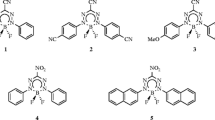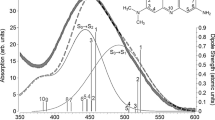Abstract
The first bright transition of a series of ten retinal-based dyes was simulated using TD-DFT, with several hybrid functionals, and with several post-Hartree–Fock methods. The CASPT2 results were used as reference to compare the results. The comparisons were not only based on the transitions energies, that is generally the case for such works, but were also based on the variation of the electron density from the ground to the excited along with several density-based indices recently developed. Among all the results obtained, it clearly appears that the PT2 correction to the CASSCF wavefunction is increasing with the increase in the charge transfer character of the transition. As already highlighted in the literature, TD-DFT poorly reproduces transition energies of this family of molecules whatever the functional. This work also confirms this observation for the variation of the electron density that is different between TD-DFT and CASPT2. Nevertheless, some functionals give better results than others. It appears that functionals having a fraction of 40–50 % of exact exchange give a better description of the electron density variation than the other functionals. Moreover, the best functional to compute the transition energies is not the best to simulate excited electron density that confirms an observation done in the literature on a different family of molecules.












Similar content being viewed by others
References
Kandori H, Shichida Y, Yoshizawa T (2001) Photoisomerization in rhodopsin. Biochemistry 66:1197–1209
Palczewski K (2012) Chemistry and biology of vision. J Biol Chem 287:1612–1619
Wald G (1968) Molecular basis of visual excitation. Nature 219:800–807
Rivalta I, Nenov A, Garavelli M (2014) Modelling retinal chromophores photoisomerization: from minimal models in vacuo to ultimate bidimensional spectroscopy in rhodopsins. Phys Chem Chem Phys 16:16865–16879
Garavelli M, Vreven T, Celani P et al (1998) Photoisomerization path for a realistic retinal chromophore model: the nonatetraeniminium cation. J Am Chem Soc 120:1285–1288
González-Luque R, Garavelli M, Bernardi F et al (2000) Computational evidence in favor of a two-state, two-mode model of the retinal chromophore photoisomerization. Proc Natl Acad Sci 97:9379–9384
Polli D, Altoè P, Weingart O et al (2010) Conical intersection dynamics of the primary photoisomerization event in vision. Nature 467:440–443
Valsson O, Filippi C, Casida ME (2015) Regarding the use and misuse of retinal protonated Schiff base photochemistry as a test case for time-dependent density-functional theory. J Chem Phys 142:144104
Buda F, Gianozzi P, Mauri F (2000) Density functional theory study of the structure and 13C chemical shifts of retinylidene iminium salts. J Phys Chem B 104:9048–9053
Guido CA, Jacquemin D, Adamo C, Mennucci B (2010) On the TD-DFT accuracy in determining single and double bonds in excited-state structures of organic molecules. J Phys Chem A 114:13402–13410
Rajput J, Rahbek DB, Andersen LH et al (2010) Probing and modeling the absorption of retinal protein chromophores in vacuo. Angew Chem Int Ed 49:1790–1793
Fujimoto K, Hayashi S, Hasegawa JY, Nakatsuji H (2007) Theoretical studies on the color-tuning mechanism in retinal proteins. J Chem Theor Comput 3:605–618
Schreiber M, Fulscher MP, Bub V (2001) The electronic spectra of symmetric cyanine dyes: a CASPT2 study. Phys Chem Chem Phys 3:3906–3912
Peach MJG, Benfield P, Helgaker T, Tozer DJ (2008) Excitation energies in density functional theory: an evaluation and a diagnostic test. J Chem Phys 128:044118
Guido CA, Cortona P, Mennucci B, Adamo C (2013) On the metric of charge transfer molecular excitations: a simple chemical descriptor. J Chem Theor Comput 9:3118
Etienne T, Assfeld X, Monari A (2014) Toward a quantitative assessment of electronic transitions’ charge-transfer character. J Chem Theor Comput 10:3896–3905
Etienne T, Assfeld X, Monari A (2014) new insight into the topology of excited states through detachment/attachment density matrices-based centroids of charge. J Chem Theor Comput 10:3906–3914
Le Bahers T, Adamo C, Ciofini I (2011) A qualitative index of spatial extent in charge-transfer excitations. J Chem Theor Comput 7:2498–2506
Ronca E, Angeli C, Belpassi L et al (2014) Density relaxation in time-dependent density functional theory: combining relaxed density natural orbitals and multireference perturbation theories for an improved description of excited states. J Chem Theor Comput 10:4014–4024
Jacquemin D, Le Bahers T, Adamo C, Ciofini I (2012) What is the “best” atomic charge model to describe through-space charge-transfer excitations? Phys Chem Chem Phys 14:5383–5388
Mewes SA, Plasser F, Dreuw A (2015) Communication: exciton analysis in time-dependent density functional theory: how functionals shape excited-state characters. J Chem Phys 143:171101
Ciofini I, Le Bahers T, Adamo C et al (2012) Through-space charge transfer in rod-like molecules: lessons from theory. J Phys Chem C 116:11946–11955
Le Bahers T, Brémond E, Ciofini I, Adamo C (2014) The nature of vertical excited states of dyes containing metals for DSSC applications: insights from TD-DFT and density based indexes. Phys Chem Chem Phys 16:14435–14444
Warnan J, Favereau L, Meslin F et al (2012) Diketopyrrolopyrrole-porphyrin conjugates as broadly absorbing sensitizers for dye-sensitized solar cells. ChemSusChem 5:1568–1577
Ehara M, Fukuda R, Adamo C, Ciofini I (2013) Chemically intuitive indices for charge-transfer excitation based on SAC-CI and TD-DFT calculations. J Comput Chem 34:2498–2501
Schreiber M, Silva-Junior MR, Sauer SP, Thiel W (2008) Benchmarks for electronically excited states: CASPT2, CC2, CCSD, and CC3. J Chem Phys 128:134110
Bravaya K, Bochenkova A, Granovsky A, Nemukhin A (2007) An opsin shift in rhodopsin: retinal S0–S1 excitation in protein, in solution, and in the gas phase. J Am Chem Soc 129:13035–13042
Roos BO, Taylor PR (1980) A complete active space SCF method (CASSCF) using a density matrix formulated super-CI approach. Chem Phys 48:157–173
Hariharan PC, Pople JA (1973) The influence of polarization functions on molecular orbital hydrogenation energies. Theor Chim Acta 28:213–222
Steffen C, Thomas K, Huniar U et al (2010) MOLCAS7: the next generation. J Comput Chem 31:2967–2970
Andersson K, Malmqvist P, Roos BO et al (1990) Second-order perturbation theory with a CASSCF reference function. J Phys Chem 94:5483–5488
Finley J, Malmqvist P-A, Roos BO, Serrano-Andrés L (1998) The multi-state CASPT2 method. Chem Phys Lett 288:299–306
Serrano-Andrés L, Merchán M, Lindh R (2005) Computation of conical intersections by using perturbation techniques. J Chem Phys 122:104107
Frisch MJ, Trucks GW, Schlegel HB et al (2009) Gaussian. Gaussian Inc
Adamo C, Barone V (1999) Toward reliable density functional methods without adjustable parameters: the PBE0 model. J Chem Phys 110:6158–6170
Zhao Y, Truhlar DG (2008) The M06 suite of density functionals for main group thermochemistry, thermochemical kinetics, noncovalent interactions, excited states, and transition elements: two new functionals and systematic testing of four M06-class functionals and 12 other function. Theor Chem Acc 120:215–241
Yanai T, Tew DP, Nicholas HC (2004) A new hybrid exchange-correlation functional using the Coulomb-attenuating method (CAM-B3LYP). Chem Phys Lett 393:51–57
Chai J-D, Head-Gordon M (2008) Long-range corrected hybrid density functionals with damped atom–atom dispersion corrections. Phys Chem Chem Phys 10:6615
Peverati R, Truhlar DG (2011) Improving the accuracy of hybrid meta-GGA density functionals by range separation. J Phys Chem Lett 2:2810–2817
Adamo C, Le Bahers T, Savarese M et al (2015) Exploring excited states using time dependent density functional theory and density based indexes. Coord Chem Rev 304–305:166–178
Jacquemin D, Perpète EA, Ciofini I, Adamo C (2009) Accurate simulation of optical properties in dyes. Acc Chem Res 42:326–334
Kochendoerfer GG, Lin SW, Sakmar TP, Mathies RA (1999) How color visual pigments are tuned. Trends Biochem Sci 24:300–305
Nielsen MB (2009) Model systems for understanding absorption tuning by opsin proteins. Chem Soc Rev 38:913–924
Wanko M, Hoffmann M, Strodel P et al (2005) Calculating absorption shifts for retinal proteins: computational challenges. J Phys Chem B 109:3606–3615
Acknowledgments
We acknowledge the PSMN calculation center for providing computational resources.
Author information
Authors and Affiliations
Corresponding authors
Additional information
Published as part of the special collection of articles “Charge Transfer Modeling in Chemistry”.
Electronic supplementary material
Below is the link to the electronic supplementary material.
Rights and permissions
About this article
Cite this article
Demoulin, B., El-Tahawy, M.M.T., Nenov, A. et al. Intramolecular photo-induced charge transfer in visual retinal chromophore mimics: electron density-based indices at the TD-DFT and post-HF levels. Theor Chem Acc 135, 96 (2016). https://doi.org/10.1007/s00214-016-1815-y
Received:
Accepted:
Published:
DOI: https://doi.org/10.1007/s00214-016-1815-y




